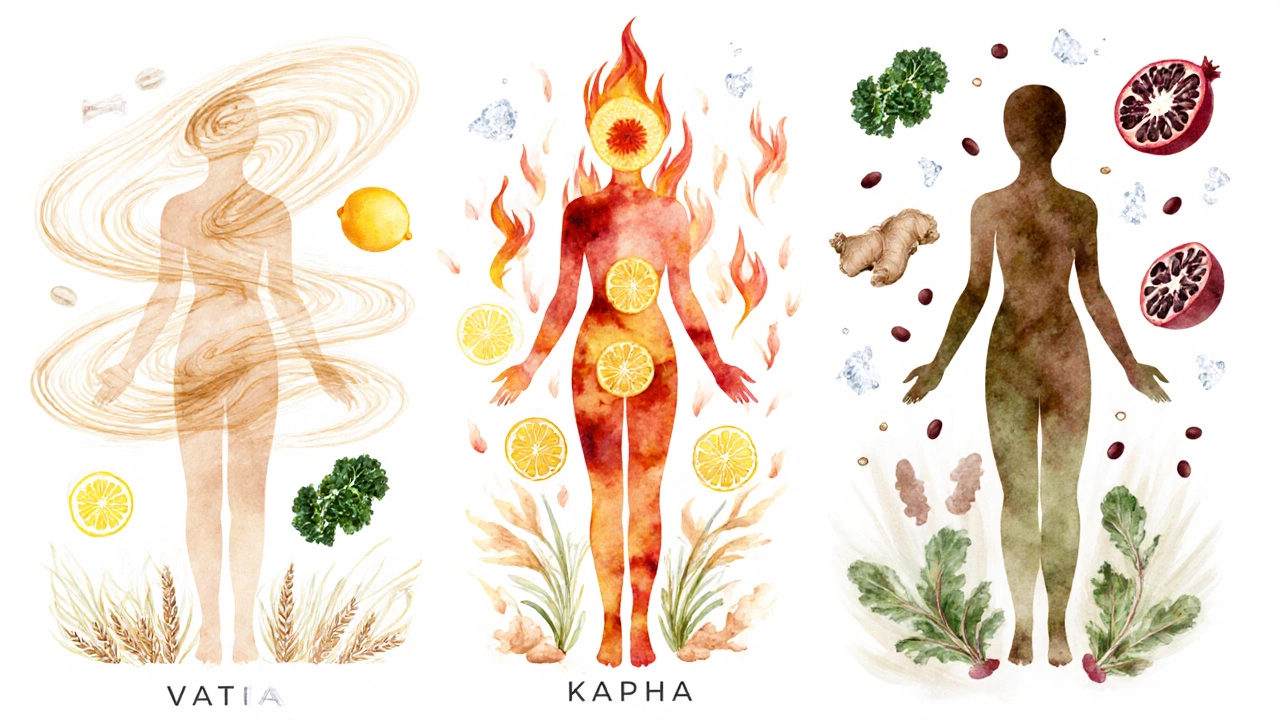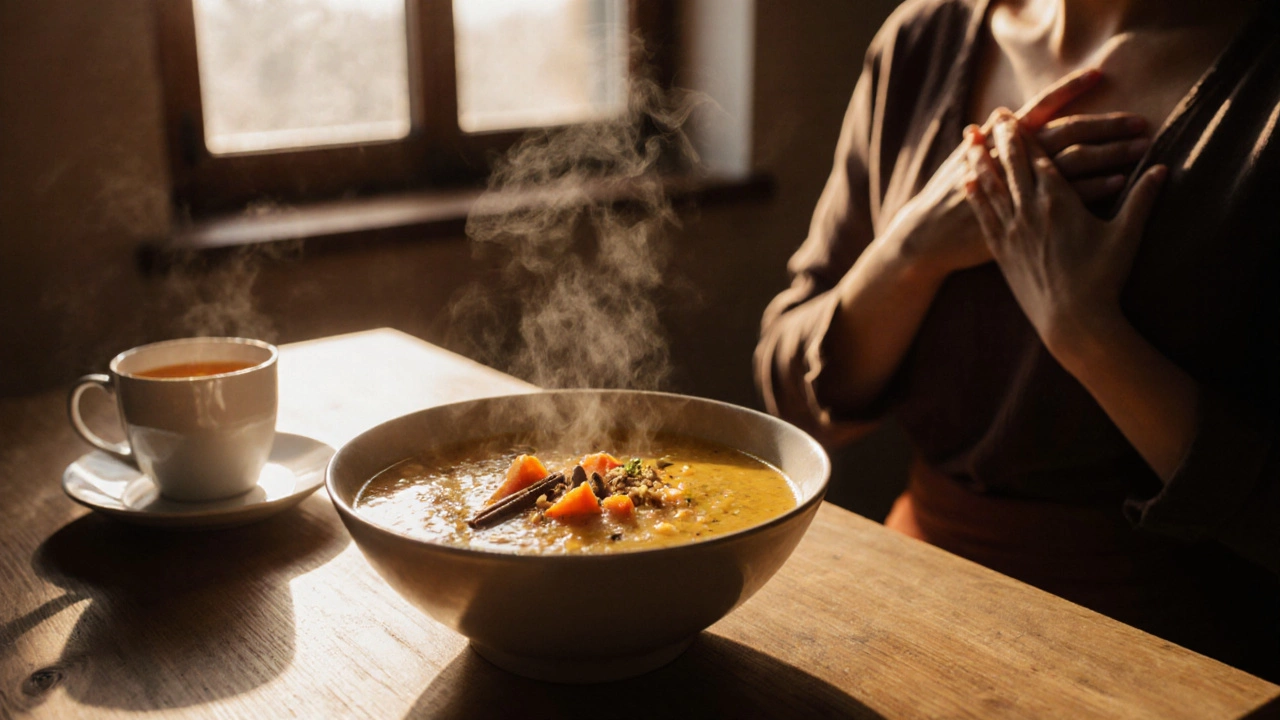Ayurvedic Dosha Identification Quiz
Discover Your Ayurvedic Constitution
Answer 5 simple questions to identify your dominant dosha and get personalized dietary recommendations.
Ever wonder why some people swear by a bowl of warm spiced soup while others thrive on a quick sandwich? The answer often lies in how the food matches the body’s inner rhythm. Ayurvedic diet is a dietary system derived from ancient Indian medicine that aligns food choices with an individual's unique constitution and the changing seasons.
Core Philosophy: Elements, Doshas, and Balance
At the heart of the Ayurvedic diet are the three Dosha energy patterns-Vata, Pitta, and Kapha-that govern physical, mental, and emotional functions. Each dosha is a blend of two of the five elements (earth, water, fire, air, ether). When your diet respects your dominant dosha, digestion (known as Agni the body’s digestive fire that transforms food into energy) stays strong, and you feel steady.
Identify Your Constitution (Prakriti)
Before you can pick foods, you need to know your Prakriti the innate constitution you’re born with, reflecting a specific dosha combination. A quick self‑assessment-looking at body shape, skin type, and temperament-helps you pinpoint whether you’re primarily Vata, Pitta, or Kapha. This classification isn’t a label; it’s a guide on what flavors, cooking methods, and meal timing will keep you in harmony.
The Six Tastes (Rasa) and Food Groups
Ayurveda teaches that all food can be broken down into six basic tastes, called Six tastes sweet, sour, salty, bitter, pungent, and astringent, each influencing the doshas in distinct ways. A balanced meal includes at least three tastes, ensuring that no single dosha is overstimulated. For example, sweet (like grains) pacifies Vata, sour (like citrus) balances Kapha, and bitter (like leafy greens) cools Pitta.
Meal Timing, Digestion, and Agni
When you eat matters as much as what you eat. Ayurveda recommends the largest meal at midday when Agni is at its peak. Light breakfasts and early dinners prevent the digestive fire from weakening. Skipping meals or eating late at night can turn Agni into "low fire," leading to bloating, fatigue, and weight gain.
Seasonal & Regional Adjustments
Just as your dosha changes with age, it also shifts with the seasons. In winter, the cold, dry air aggravates Vata, so warm, moist foods (soups, stews, ghee) are encouraged. Summer heats up Pitta; cooling foods like cucumber, coconut water, and sweet fruits become allies. Kapha benefits from light, dry fare in spring to counteract its natural heaviness.

Sample Daily Menus for Each Dosha
Below are practical examples of a day’s meals tailored to each constitution. Adjust portion sizes to your appetite, but keep the dosha‑specific principles in mind.
- Vata: Warm oatmeal with almond milk, cinnamon, and a handful of raisins for breakfast; a lentil soup seasoned with ginger and cumin for lunch; roasted sweet potatoes with ghee and sautéed greens for dinner.
- Pitta: Fresh fruit salad with mint for breakfast; quinoa salad with cucumber, cilantro, and a dash of lime for lunch; grilled fish with coriander chutney and steamed broccoli for dinner.
- Kapha: Light millet porridge with a touch of honey for breakfast; mixed bean stir‑fry with mustard seeds, turmeric, and lots of pepper for lunch; baked tofu with roasted cauliflower and a side of arugula for dinner.
Common Pitfalls & How to Transition Smoothly
Switching to an Ayurvedic way of eating can feel restrictive at first. Here are three traps to avoid:
- Going all‑in overnight: Introduce one dosha‑friendly change each week-swap coffee for warm ginger tea, add a spice, or shift dinner 30 minutes earlier.
- Ignoring personal cravings: Your body still signals needs. If you crave something sweet, choose natural sweeteners like dates instead of refined sugar.
- Neglecting digestion: Keep a diary of how foods affect your energy and bowel habits. Adjust spices or timing accordingly.
Ayurvedic Diet vs. Typical Western Diet
| Aspect | Ayurvedic Diet | Western Diet |
|---|---|---|
| Primary focus | Balancing doshas & supporting Agni | Calorie counting & macronutrient ratios |
| Food selection | Six tastes, seasonal, dosha‑specific | Processed foods, fast carbs, high sugar |
| Meal timing | Largest meal at midday, early dinner | Irregular, late-night snacking common |
| Cooking method | Gentle heat, use of ghee, spices for digestion | Microwave, deep‑frying, minimal spices |
| Mind‑body link | Food as medicine, supports mental clarity | Often separated from health considerations |
Key Takeaways
- The Ayurvedic diet tailors food to your unique Prakriti and seasonal changes.
- Balancing the six tastes in each meal keeps the three Dosha in harmony.
- Strong Agni means better digestion, higher energy, and clearer skin.
- Start small: introduce warm spices, adjust meal timing, and track how your body feels.
- Compared with a typical Western diet, the Ayurvedic approach emphasizes quality, timing, and the mind‑body connection.
If you’re curious about the Ayurvedic diet, try swapping one processed snack a day for a fresh fruit or a handful of soaked nuts and notice the difference.

What is the main goal of an Ayurvedic diet?
The primary aim is to keep the three Dosha in balance, which supports optimal digestion (Agni) and overall well‑being.
How do I know my dosha?
You can take a simple online questionnaire or consult an Ayurvedic practitioner who evaluates your body shape, skin, digestion, and temperament to identify whether you’re mainly Vata, Pitta or Kapha.
Can the Ayurvedic diet help with weight loss?
Yes, when you eat foods that suit your dosha and avoid the tastes that aggravate your dominant type, metabolism improves and cravings drop, making weight management easier.
Is it necessary to avoid all meat?
Many Ayurvedic guidelines favor plant‑based foods, but modest amounts of well‑cooked, lightly spiced meat can be okay for certain doshas, especially Pitta, if it doesn’t upset Agni.
What spices are most important for digestion?
Ginger, cumin, fennel, and black pepper are classic Ayurvedic spices that ignite Agni and aid nutrient absorption.






